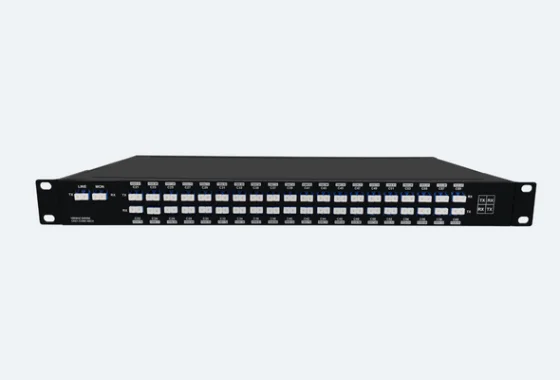- This topic is empty.
-
AuthorPosts
-
06/04/2025 at 23:01 #8250
In the fast-evolving world of telecommunications, fiber-optic networks continue to serve as the backbone for high-speed data transmission. As the demand for bandwidth grows exponentially, solutions that can optimize fiber usage are in high demand. One of the most crucial technologies that have emerged to meet these demands is Dense Wavelength Division Multiplexing (DWDM) and its associated technology, the DWDM Multiplexer (DWDM MUX). This article WDMLight explores the role and advantages of DWDM MUX, shedding light on why it plays such a pivotal role in modern telecommunications infrastructure.

The Role of DWDM MUX in Modern Networks
The DWDM MUX is an integral component in any high-capacity optical network. By leveraging the power of wavelength multiplexing, it allows service providers to increase the data transmission capacity of a single fiber. This is especially crucial as the demand for high-speed internet, video streaming, cloud computing, and data storage grows rapidly.
A DWDM MUX typically consists of several optical filters and multiplexing components, which ensure that each data stream is assigned to a specific wavelength with minimal interference. These multiplexers come in various configurations, including standalone units and those integrated into larger optical transport systems. In a DWDM system, the MUX is responsible for:
Wavelength Division
The MUX divides the available bandwidth into several distinct channels by assigning each data stream to a unique wavelength. This allows operators to utilize all available fiber bandwidth without interference from other signals. For instance, a 10 Gbps DWDM MUX might allow operators to allocate multiple 10 Gbps data streams, increasing the total capacity of the fiber link.
Signal Aggregation
The DWDM MUX combines these multiple wavelengths into a single, high-capacity optical signal. This aggregation allows operators to transmit large volumes of data without increasing the number of physical fibers used in the network. For example, with DWDM technology, a single fiber can be used to carry 100 wavelengths, with each one transmitting data at 10 Gbps, effectively turning one fiber into a 1 Tbps link.
Optimization of Network Capacity
With DWDM MUX technology, operators can maximize their existing fiber infrastructure, thereby increasing the overall efficiency and capacity of their networks. This capability is essential in scenarios where infrastructure expansion is either impractical or too costly. Operators can scale their networks without the need for laying new cables, which helps avoid significant investments and construction delays.
The role of DWDM MUX is not only critical in boosting the capacity of optical networks but also plays a key part in enhancing network flexibility. It enables better management of bandwidth, allowing service providers to accommodate varying data traffic demands at different times of the day or across different regions, ensuring a balanced network load.
Advantages of DWDM MUX Technology
The DWDM MUX technology brings several advantages to network operators, businesses, and service providers, making it a crucial component of modern optical networks:
High Capacity and Scalability
DWDM MUX systems offer remarkable scalability by enabling the multiplexing of numerous channels onto a single optical fiber. The system's capacity can easily be expanded by adding additional wavelengths, making it possible to support increasing traffic demands without requiring significant changes to the underlying fiber infrastructure. For instance, operators can start with a relatively low number of channels and expand as data traffic grows, making DWDM MUX a flexible and cost-effective solution.
Efficient Use of Existing Infrastructure
With the growing demand for data and bandwidth, it is often impractical to lay new fiber cables to accommodate additional traffic. DWDM MUX allows operators to make full use of their existing fiber optic infrastructure, maximizing its capacity and minimizing the need for expensive and time-consuming fiber installations. The system optimizes the utilization of the fiber's optical spectrum, reducing the overall cost of bandwidth expansion.
Enhanced Network Reliability
DWDM MUX technology also helps improve network reliability by reducing the number of physical links required for data transmission. This decreases the likelihood of network failures due to fiber cuts, environmental factors, or physical damage. Moreover, the multiplexed nature of DWDM makes it easier to perform fault isolation and recovery in the event of a network issue. Network reliability is a major consideration in large-scale deployments, and DWDM MUX helps ensure that data transmission remains uninterrupted.
Cost Efficiency
By increasing the capacity of a single fiber, DWDM MUX technology significantly reduces the cost of bandwidth expansion. Network operators can increase the number of channels on their fiber-optic network without the need for costly upgrades to the underlying infrastructure. Additionally, the long-range capabilities of DWDM systems help reduce operational costs related to network maintenance. The reduced need for physical hardware installations results in lower capital and operational expenditures.
Low Latency Transmission
As data traffic continues to grow, minimizing latency has become an important consideration in network design. DWDM MUX allows for low-latency, high-speed data transmission, ensuring that applications such as video conferencing, online gaming, and cloud computing operate with minimal delay. Low latency is particularly critical in applications where real-time communication is essential, such as in trading platforms or mission-critical communications.
In conclusion, the DWDM MUX technology plays a vital role in optimizing the capacity of fiber-optic networks, providing a cost-effective, scalable, and reliable solution for the ever-growing demands of modern data transmission. Whether in long-distance communication, data center interconnectivity, or enterprise networks, DWDM MUX systems offer a way to meet the increasing need for bandwidth without requiring costly infrastructure upgrades. As businesses and telecommunications providers continue to expand their network capabilities, the importance of DWDM MUX technology in delivering high-performance optical networks will only grow. With its ability to maximize fiber efficiency and provide low-latency, high-capacity transmission, DWDM MUX will remain an indispensable tool in the evolution of modern telecommunications.
https://www.wdmlight.com/Maximizing-Fiber-Network-Efficiency-with-DWDM-MUX-Technology.html
https://www.wdmlight.com/DWDM-Mux-Demux
http://www.wdmlight.com
WDMLight -
AuthorPosts
- You must be logged in to reply to this topic.



